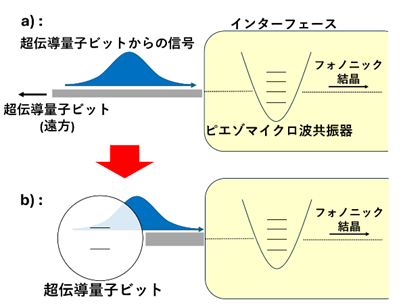Progress Report
Development of Quantum Interfaces for Building Quantum Computer Networks[3] Piezoelectric Microwave Cavity
Progress until FY2024
1. Outline of the project
This project aims to develop a quantum interface that connects superconducting qubits with photons for communication to realize a large-scale distributed superconducting quantum computer. In this R&D theme, we will develop a piezoelectric microwave resonator that will be a component of the system (Fig. 1). In this R&D theme, we have achieved the following outcome.

2. Outcome so far
Subject 1: Piezoelectric Microwave Cavity
Microwave photons emitted by superconducting qubits are converted into phonons through the piezoelectric effect. For these phonons to interact efficiently with nitrogen-vacancy (NV) centers, they must be confined in a very small area—about the size of one wavelength or even smaller—using a resonator with an extremely small mode volume. As a preliminary step toward the final device, we used a small-mode-volume surface acoustic wave device fabricated on an AlN/diamond substrate (Fig. 2) to check if the interaction with the NV centers was enhanced. We demonstrated that reducing the mode volume increases the interaction efficiency between the NV center and phonons. The next step is to integrate microwave resonators, optical resonators, and the acoustic resonator to develop a device that achieves high microwave-to-optical conversion efficiency (Fig. 2).

Subject 2: Quantum-Controlled Electronic Integrated Circuits
To achieve fast and high-fidelity quantum control of quantum circuits at cryogenic temperatures, we have developed a superconducting microwave pulse generator capable of generating microwaves of arbitrary amplitude (Fig. 3). The system utilizes a single flux quantum (SFQ) circuit to generate a 5 GHz SFQ pulse train, which is then shaped into a 5 GHz microwave pulse with variable amplitude using a superconducting filter.

Subject 3: Theoretical study of quantum interface
We theoretically analyzed the coherent conversion efficiency of a microwave photon (emitted from a superconducting qubit) into an optical photon (suitable for long-distance propagation), using a device composed of a microwave resonator, a phonon resonator, a diamond NV center, and an optical resonator, which is expected to be fabricated in this project. The device requires irradiation of a drive field to the optical resonator. By switching to a rotational frame at the drive frequency, we can map the present device onto a coupled system of five linear oscillators at the microwave frequencies. We estimated the coherent conversion efficiency by applying the input-output theory to this five-oscillators coupled system. The efficiency is estimated to be 96% for the ideal system without internal losses and 25% for the actual system with internal losses (Fig. 4).

3. Future plans
We will improve the performance of piezoelectric microwave cavities and integrate them with optomechanical cavities with quantum memory.